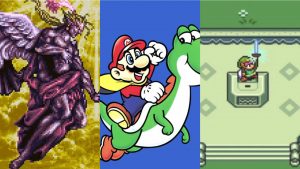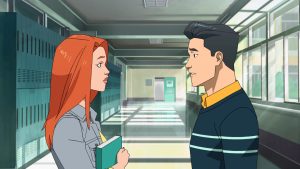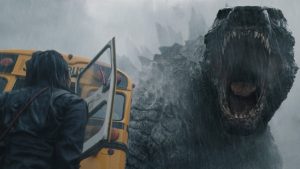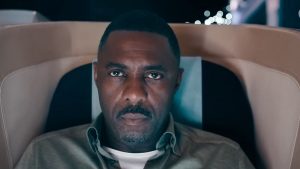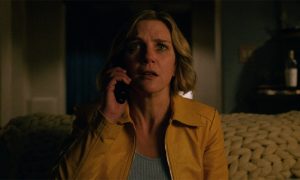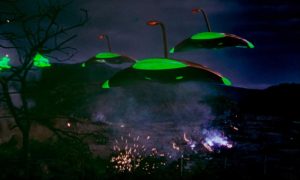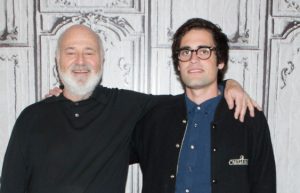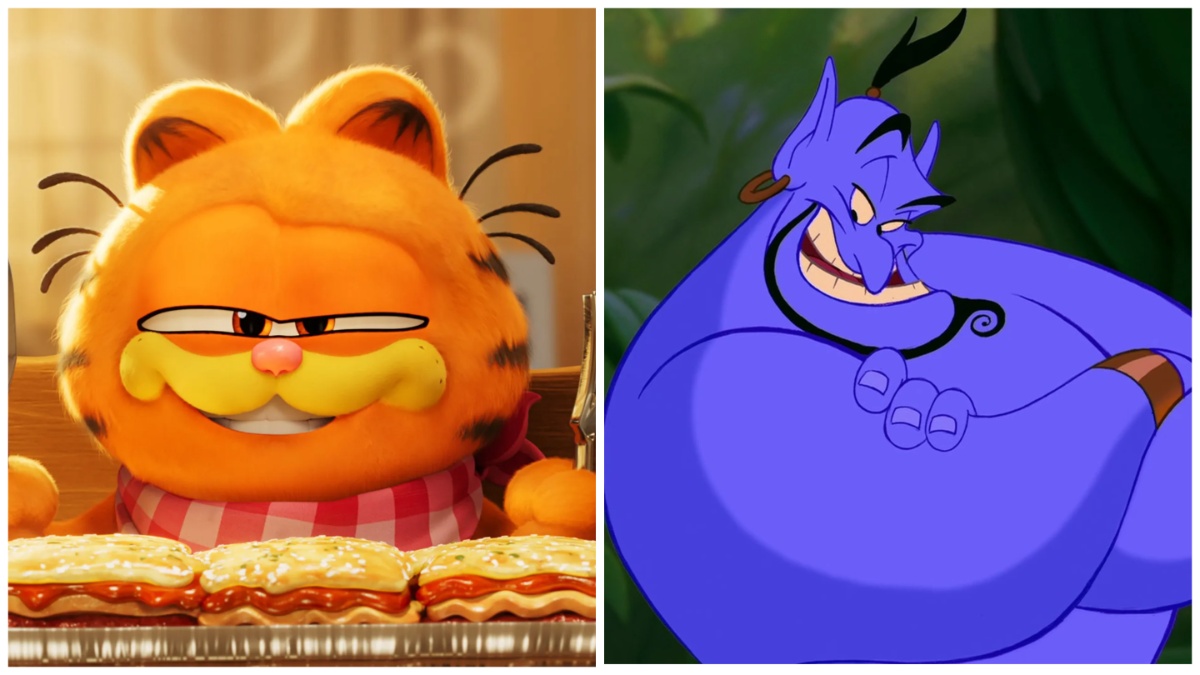
Recently, I watched the trailer for Transformers One, the Cybertron-set sequel about the origins of Optimus Prime and Megatron. Every time I see that trailer attached to whatever movie, an unenthusiasm washes over. It’s mainly a byproduct of Chris Hemsworth and Brian Tyree Henry’s casting as pre-Adam’s-apple-dropped versions of their respective characters. And make no mistake, they did not change their voices at all for these roles.
It’s not just Transformers One that’s the butt of this phenomenon though. Nearly every animated movie emphasizes a celebrity voice cast as part of its marketing. How else can you explain the overexposure of Chris Pratt as this weekend’s Garfield and last year’s Super Mario? It’s even standard day practice now for the character poster to also feature an actor’s name above the animation design, a la “Zendaya is Meechee.” This exists, presumably, to lure adults into the theater. Occasionally, an animated movie would provide a central voice cast befitting their animated counterparts, and without the celebrity title being a prerequisite for their addition ––i.e., the upcoming Ultraman: Rising and Aang: The Last Airbender.
However, you can’t seem to escape movies that need to push out their voice cast, which often bumps up an animated movie’s budgetary price tag that otherwise would have been considerably lowered if studios entrusted talented voice actors who treat their jobs as professional and not a paycheck that will earn “cool points” with their kids. Alas much of today’s benign practices trace back to Mr. Quibi himself: the AI-animation defender, one-third of Dreamworks founder, and former Disney-animation head, Jeffrey Katzenberg.
Katz v. Williams
Before the man became the industry’s four-month streaming video legend, Katzenberg was one of Disney’s top brass in the late 1980s and early ‘90s, answering only to his friend-turned-enemy, Michael Eisner. And during this run, they did turn Walt Disney Animation Studios around. Early into his tenure as chairman of Walt Disney Studios, part of Katzenberg’s strategy to make Disney animated flicks relevant again was nabbing all-star talents to round out the voice cast. Case in point is the 1988-released Oliver & Company, which heavily marketed Bette Midler, Billy Joel, and Huey Lewis’ inclusion across trailers and commercials. While that movie succeeded financially on a $31 million budget, it wasn’t until Aladdin that Katz went a little crazy.
Around early 1990, Robin Williams became the Hollywood IT man. He turned out to be a significant dramedy star in addition to a successful stand-up comedy career. He also had a massive love for animation and adored the artistry behind it.
Before Aladdin, Williams signed on to star as Batty Koda in Kroyer Films’ animated project, FernGully: The Last Rainforest. Williams recorded 14 lines of improvised dialogue, and it was so good that they wound up tripling Batty’s initially eight-minute set of screentime. The actor agreed to take on the voice acting gig because he appreciated the environmentalist message behind the film. Then while doing FernGully, Williams signed on for Aladdin as Genie—another character written and designed in mind for him because of his naturally animated energy. He also agreed to be paid at a scale rate of $75,000 because “he wanted to leave something wonderful behind for his kids.” His only contractual demand was not to use his voice as Genie to sell merchandise.
Before the studio went back on his wishes (and according to Williams overdubbed his voice in toy and fast food commercials), Katzenberg tried to pull some spoiled kid power moves and convince Williams to prioritize Genie over Batty. Firstly, Katzenberg went up to Williams directly and told him that he couldn’t voice Batty and Genie simultaneously for whatever reasons, despite no written contracts expressing this. When Williams stood on Batty’s side, Katzenberg pulled some petty Bugs Bunny stuff, declaring war and using his Disney power to sabotage FernGully’s production.
Several incidents involved the FernGully team trying to rent facilities to do production work, and the Katz Man finding out all the locations they were at and buying or renting out those spaces so production would stall. Screenwriter Jim Cox recalled, “Katzenberg did not want him voicing two animated characters in two animated movies at the same time, and tried to force Robin not to do it. Robin was steaming, like ‘it’s my voice! You can’t stop me.’”
Disney’s false promises pushed Williams over the edge as much of Aladdin‘s marketing went all in on selling Genie as fast food toys and other paraphernalia. Williams became pissed when Katzenberg was touting his performance for the holiday awards season. Upon winning a “special achievement award” Golden Globe, Williams didn’t mention Disney at all in his acceptance speech and took a shot at Katzenberg by calling him “KatzenBUG.”
Star-Studded Disney and the Dawn of DreamWorks
Across the remaining animated flicks he worked on under the Mouse House, Katzenberg made sure his celebrity rhetoric applied to all features, with each project becoming more star-studded than the last, including The Lion King accumulating Matthew Broderick, James Earl Jones, Rowan Atkinson, and Jeremy Irons, and Pocahontas featuring Christian Bale and Mel Gibson as the dullest characters in Disney history. The future Mr. Quibi was so deluded by his starry-eyed daze that we probably would’ve seen bizarre concepts like Steve Martin as Goofy in A Goofy Movie become a reality.
When Katzenberg lost his pass to the Magic Kingdom though, and made DreamWorks SKG, alongside Steven Spielberg and David Geffen, a live-action and animation alternative to Disney, his first order of business was to make every feature so star-studded it would cause people to flock into theaters.
For their first released feature, Antz, DreamWorks enlisted a voice cast full of A-list talent at the time, including Sylvester Stallone, Sharon Stone, Gene Hackman, Jennifer Lopez, Christopher Walken, and (ugh) Woody Allen in the lead role. This was meant to sell it to an older demographic. The same goes for The Prince of Egypt with Val Kilmer, Ralph Fiennes, Steve Martin, Sandra Bullock, Martin Short, and Patrick Stewart all playing either Egyptians or Jewish characters. While both became financially successful in their own right, neither stood a chance against Disney’s stranglehold on the market.
It wasn’t until the 2001 success of Shrek, the pettiest animated movie ever made, and possibly one of the most iconic, that Katz’s model seemed to work. It became the fourth highest-grossing movie of the year and nabbed DWA their first slew of awards, including the first ever Best Animated Feature Oscar.
After that, every animated movie adopted that approach, whether it be from promising new startups such as Sony Pictures Animation and Blue Sky Studios—which came out the gate marketing its celebrity voices in their feature debut, Ice Age—or acquired animated projects from the disgraced Harvey Weinstein. Even Nickelodeon followed the leader. Hey, remember how Bruce Willis was front and center across Rugrats Go Wild‘s marketing so every kid’s Die Hard-loving dad could have something to laugh at while they were forced to smell those infamous scratch-n-sniff cards?! It was a dark time, indeed.
It’s All Star-dard Practice
Disney also gave in to Katz’s Dominance by adopting this practice. While not initially touting its voice cast in trailers due to confidence in its brand recognition, it wasn’t until Pixar‘s Cars and Disney Animation’s Bolt that the studio stepped out its recognizable bankable voice talent to lead their marketing. There was no way to escape from every trailer’s emphasis on John Travolta and Miley Cyrus’ starring in Bolt, because that was the perfect generation divide among moviegoers.
Meanwhile DreamWorks made it known that all of their features had grade-A talent lending their voices for whatever animated project at the time, for better (Over the Hedge) or worse (Shark Tale). But since DreamWorks was thriving amid Disney’s financial L’s across the early 2000s, it resulted in celebrity voice casting and an overabundance of CG-animated features becoming the industry standard in Hollywood. Now animated movies are about who stars in them rather than selling what they are about.
While sometimes it bodes well for the studio, no kid today cares about who stars in a movie, nor do I assume do their parents. Back in the day, DreamWorks’ final two-dimensional animated movie, Sinbad, which starred Brad Pitt, Catherine Zeta-Jones, Michelle Pfeiffer, etc., was a big box office bomb during the same season of Finding Nemo. While this mainly contributed to the decreasing of hand-drawn animation in the market, and audiences’ preference for the relatively new three-dimensional animated feature, when CG was normalized, studios learned the hard way that a celebrity voice cast doesn’t warrant automatic success.
One example is the now-defunct DNA Productions, responsible for the wildly successful Jimmy Neutron: Boy Genius, a movie that got by on its CG quality, Nickelodeon-associated brand recognition, and character integration amongst the rest of the Nicktoons via shorts before release. In 2006, they produced The Ant Bully, and its entire marketing conformed to the norms by having Julia Roberts, Nicolas Cage, Meryl Streep, Paul Giamatti, Regina King, Bruce Campbell, and Lily Tomlin round out the voice cast. Alas, it bombed and put the studio out of business. In contrast, Jimmy Neutron‘s most prominent stars were Patrick Stewart and Martin Short, who were already proficient in voice acting.
Dismantle the Celeb System
Today, I propose dismantling the Jeffrey Katzenberg institution of celebrity voice casting. In a time when more animated movies are being commissioned based on intellectual property, more roles are given to people who think of the profession as an easy paycheck that could be done in their pajamas. Voice acting is a skill for many artists who, like the late Robin Williams, respect the profession and know they’re providing a personality and dimension to a character.
Regardless of their faces being hidden behind a series of drawings, voice acting is as physically laborious as any other profession and requires a lot of hard work. One’s inflection can make or break how others perceive a character. Usually, when a celebrity is doing their natural voice, leaving little room for a persona in the vocal booth, it does a disservice to the project in its entirety, from the writers to the animators, all of whom are trying to make a meaningful story that they hope will resonate with a wide audience. While I can make a case for some decent Chris Pratt or Awkwafina vocal performances in film, their overexposure across the medium lessens anyone’s desire to see a movie. There’s a reason why people were making memes over The Super Mario Bros. Movie‘s initial voice-casting announcement.
As Katzenberg has become as obsolete as the app that tarnished whatever shred of reputability he had in the industry, the same should extend to the studios’ desire to seek out famous folk to bring recognizable characters to life.
The post Animated Movies Need to Stop Celebrity Stunt Casting appeared first on Den of Geek.

